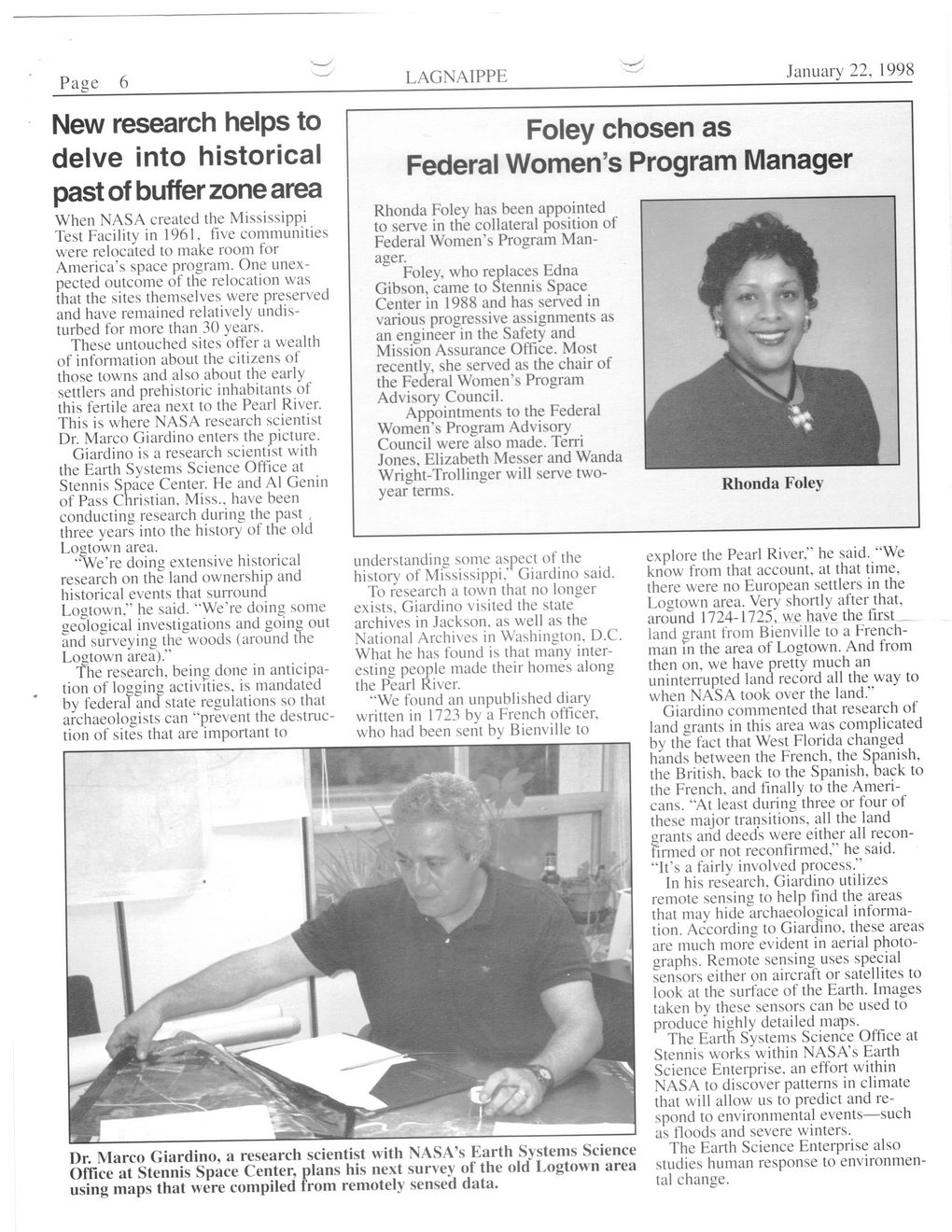This text was obtained via automated optical character recognition.
It has not been edited and may therefore contain several errors.
Page 6 LAGNAIPPE January 22, 1998 Foley chosen as Federal Women’s Program Manager Rhonda Foley has been appointed to serve in the collateral position of Federal Women’s Program Manager. Foley, who replaces Edna Gibson, came to Stennis Space Center in 1988 and has served in various progressive assignments as an engineer in the Safety and Mission Assurance Office. Most recently, she served as the chair of the Federal Women’s Program Advisory Council. Appointments to the Federal Women’s Program Advisory Council were also made. Terri Jones, Elizabeth Messer and Wanda Wright-Trollinger will serve two-year terms. Rhonda Foley New research helps to delve into historical past of buffer zone area When NASA created the Mississippi Test Facility in 1961, five communities were relocated to make room for America’s space program. One unexpected outcome of the relocation was that the sites themselves were preserved and have remained relatively undisturbed for more than 30 years. These untouched sites offer a wealth of information about the citizens of those towns and also about the early settlers and prehistoric inhabitants of this fertile area next to the Pearl River. This is where NASA research scientist Dr. Marco Giardino enters the picture. Giardino is a research scientist with the Earth Systems Science Office at Stennis Space Center. He and A1 Genin of Pass Christian. Miss., have been conducting research during the past , three years into the history of the old Loetown area. "'We're doing extensive historical research on the land ownership and historical events that surround Logtown,” he said. “We’re doing some geological investigations and going out and surveying the woods (around the Logtown area).” The research, being done in anticipation of logging activities, is mandated by federal and state regulations so that archaeologists can “prevent the destruction of sites that are important to understanding some aspect of the history of Mississippi,’ Giardino said. To research a town that no longer exists, Giardino visited the state archives in Jackson, as well as the National Archives in Washington, D.C. What he has found is that many interesting people made their homes along the Pearl River. “We found an unpublished diary written in 1723 by a French officer, who had been sent by Bienville to explore the Pearl River,” he said. “We know from that account, at that time, there were no European settlers in the Logtown area. Very shortly after that, around 1724-1725, we have the first land grant from Bienville to a Frenchman in the area of Logtown. And from then on, we have pretty much an uninterrupted land record all the way to when NASA took over the land.” Giardino commented that research of land grants in this area was complicated by the fact that West Florida changed hands between the French, the Spanish, the British, back to the Spanish, back to the French, and finally to the Americans. “At least during three or four of these major transitions, all the land grants and deeds were either all reconfirmed or not reconfirmed,” he said. "It’s a fairly involved process.” In his research, Giardino utilizes remote sensing to help find the areas that may hide archaeological information. According to Giardino, these areas are much more evident in aerial photographs. Remote sensing uses special sensors either on aircraft or satellites to look at the surface of the Earth. Images taken by these sensors can be used to produce highly detailed maps. The Eartn Systems Science Office at Stennis works within NASA’s Earth Science Enterprise, an effort within NASA to discover patterns in climate that will allow us to predict and respond to environmental events—such as Hoods and severe winters. The Earth Science Enterprise also studies human response to environmental change. Dr. Marco Giardino, a research scientist with NASA’s Earth Systems Science Office at Stennis Space Center, plans his next survey of the old Logtown area using maps that were compiled from remotely sensed data.

NASA Document (020)